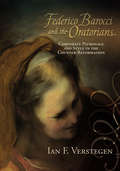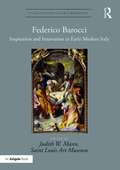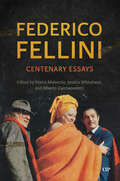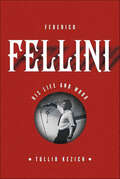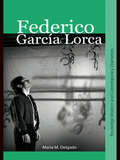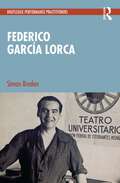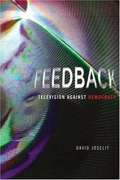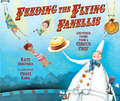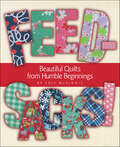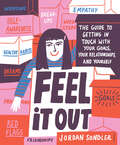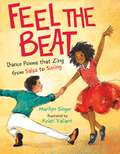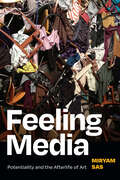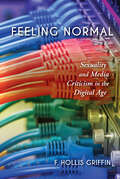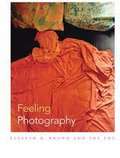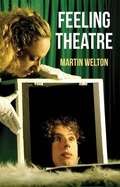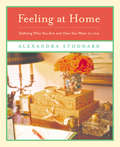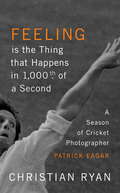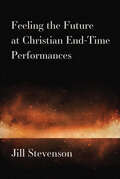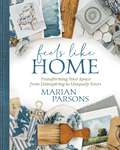- Table View
- List View
Federico Barocci and the Oratorians: Corporate Patronage and Style in the Counter-Reformation (Early Modern Studies #14)
by Ian F. VerstegenIn 1586, Federico Barocci delivered his Visitation of the Virgin and St. Elizabeth to the Chiesa Nuova in Rome. For the next quarter century, Barocci dominated the art scene in Rome; there was no other artist from whom it was harder to get work and no other artist charged such high prices. Having two important altarpieces in the Chiesa Nuova and two additional commissions discussed was an impressive feat for an artist living exclusively in Urbino. Why did the Oratorians monopolize Barocci’s talents in Rome and why does it seem that Barocci was their first choice when considering artists to decorate their church? What was it about Barocci’s art that appealed to Oratorian sensibilities and their vision of the artistic program for decoration of their church?This book examines the relationship between Barocci and the Congregation of the Oratory, arguing for a distinct physiognomy of Oratorian patronage and exposing the function the Oratorians expected of religious imagery in contrast to other groups of their time. While explaining Oratorian patronage, it thus deals with a thorny question in social science: how can a collective body have unified intentions and actions? The result is a contribution both to the history of Italian painting and to art historical methodology.
Federico Barocci and the Oratorians: Corporate Patronage and Style in the Counter-Reformation (Early Modern Studies)
by Ian F. VerstegenIn 1586, Federico Barocci delivered his Visitation of the Virgin and St. Elizabeth to the Chiesa Nuova in Rome. For the next quarter century, Barocci dominated the art scene in Rome; there was no other artist from whom it was harder to get work and no other artist charged such high prices. Having two important altarpieces in the Chiesa Nuova and two additional commissions discussed was an impressive feat for an artist living exclusively in Urbino. Why did the Oratorians monopolize Barocci’s talents in Rome and why does it seem that Barocci was their first choice when considering artists to decorate their church? What was it about Barocci’s art that appealed to Oratorian sensibilities and their vision of the artistic program for decoration of their church?This book examines the relationship between Barocci and the Congregation of the Oratory, arguing for a distinct physiognomy of Oratorian patronage and exposing the function the Oratorians expected of religious imagery in contrast to other groups of their time. While explaining Oratorian patronage, it thus deals with a thorny question in social science: how can a collective body have unified intentions and actions? The result is a contribution both to the history of Italian painting and to art historical methodology.
Federico Barocci: Inspiration and Innovation in Early Modern Italy (Visual Culture in Early Modernity)
by Judith MannReviewers of a recent exhibition termed Federico Barocci (ca. 1533–1612), 'the greatest artist you’ve never heard of'. One of the first original iconographers of the Counter Reformation, Barocci was a remarkably inventive religious painter and draftsman, and the first Italian artist to incorporate extensive color into his drawings. The purpose of this volume is to offer new insights into Barocci’s work and to accord this artist, the dates of whose career fall between the traditional Renaissance and Baroque periods, the critical attention he deserves. Employing a range of methodologies, the essays include new ideas on Barocci’s masterpiece, the Entombment of Christ; fresh thinking about his use of color in his drawings and innovative design methods; insights into his approach to the nude; revelations on a key early patron; a consideration of the reasons behind some of his most original iconography; an analysis of his unusual approach to the marketing of his pictures; an exploration of some little-known aspects of his early production, such as his reliance on Italian majolica and contemporary sculpture in developing his compositions; and an examination of a key Barocci document, the post mortem inventory of his studio. A translated transcription of the inventory is included as an appendix.
Federico Fellini
by Hava AldoubyFederico Fellini professed a desire to create "an entire film made of immobile pictures." In this study, Hava Aldouby uses this quotation as a launching point to analyze Fellini's films as sequences of "pictures" that draw extensively on art history, and particularly painting, as a reservoir of visual imagery. Aldouby employs an innovative pictorial approach that allows her to uncover a wealth of visual evocations overlooked by Fellini scholars over the years.Federico Fellini: Painting in Film, Painting on Film sheds light on the intertextual links between Fellini's films and the works of various artists, from Velazquez to Francis Bacon, by identifying references to specific paintings in his films. Using new archival evidence from Fellini's private library, brought to light for the first time here, Aldouby draws out Fellini's in-depth knowledge of art history and his systematic employment of art-historical allusions.
Federico Fellini: Centenary Essays (Toronto Italian Studies)
by Marco Malvestio Jessica Whitehead Alberto ZambenedettiA complex and at times controversial film-maker whose career spanned the second half of the twentieth century, Federico Fellini (1920–1993) remains central to the Italian cultural imagery and the object of ongoing debates and critical scrutiny at home and abroad. Images from his films – Gelsomina’s tears, Marcello’s sunglasses – have become global signifiers not only for Fellini and Italian cinema but for Italy itself, as steadily lodged in the world’s collective unconscious as the Colosseum’s arches and Venice’s gondolas. Marking the centenary of Fellini’s birth, Federico Fellini: Centenary Essays reassesses the film-maker’s legacy with diverse contributions from established and emerging Fellini scholars as well as renowned Canadian film-makers. From literary influences to pictorial references, from artistic collaborations to politics, and from exhibition history to revivals, the collection covers the pivotal aspects of Fellini’s poetics through contemporary methodological tools and features a wide array of scholarly approaches. With complexity and nuance, the book takes stock of the enormous cultural legacy of one of the most celebrated directors in cinema history and is essential reading for scholars and cinephiles alike.
Federico Fellini: His Life and Work
by Tullio KezichA lively and authoritative journey into the world of a cinema masterWith the revolutionary 8 1/2, Federico Fellini put his deepest desires and anxieties before the lens in 1963, permanently impacting the art of cinema in the process. Now, more than forty years later, film critic and Fellini confidant Tullio Kezich has written the work by which all other biographies of the filmmaker are sure to be measured. In this moving and intimately revealing account of a lifetime spent in pictures, Kezich uses his friendship with Fellini as a means to step outside the frame of myth and anecdote that surrounds him—much, it turns out, of the director's own making.A great lover of women and a meticulous observer of dreams, Fellini, perhaps more than any other director of the twentieth century, created films that embodied a thoroughly modern sensibility, eschewing traditional narrative along with religious and moral precepts. His is an art of delicate pathos, of episodic films that directly address the intersection of reality, fantasy, and desire that exists as a product of mid-century Italy—a country reeling from a Fascist regime as it struggled with an outmoded Catholic national identity. As Kezich reveals, the dilemmas Fellini presents in his movies reflect not only his personal battles but those of Italian society. The result is a book that explores both the machinations of cinema and the man who most grandly embraced the full spectrum of its possibilities, leaving his indelible mark on it forever.
Federico García Lorca (Routledge Modern and Contemporary Dramatists)
by Maria M. DelgadoImmortalized in death by The Clash, Pablo Neruda, Salvador Dalí, Dmitri Shostakovich and Lindsay Kemp, Federico García Lorca's spectre haunts both contemporary Spain and the cultural landscape beyond. This study offers a fresh examination of one of the Spanish language’s most resonant voices; exploring how the very factors which led to his emergence as a cultural icon also shaped his dramatic output. The works themselves are also awarded the space that they deserve, combining performance histories with incisive textual analysis to restate Lorca’s presence as a playwright of extraordinary vision, in works such as: Blood Wedding The Public The House of Bernarda Alba Yerma. Federico García Lorca is an invaluable new resource for those seeking to understand this complex and multifaceted figure: artist, playwright, director, poet, martyr and in the eyes of many, Spain’s ‘national dramatist’.
Federico García Lorca (Routledge Performance Practitioners)
by Simon BredenLauded as one of the most important poets and playwrights of the twentieth century, Federico García Lorca was also an accomplished theatre director with a clear process and philosophy of how drama should be staged. Directing both his own work and that of others, Lorca was also closely involved in the rehearsals for productions of many of his plays, and from his own writings and those of his collaborators, a determined agenda to stimulate audiences and renovate theatre can be seen.This is the first book in English to fully consider Lorca as a director and his rehearsal methodology. The book combines:- A biographical account of Lorca’s work as a director and rehearsal leader, revealing his techniques and methods of approach texts;- An exploration of his key writings on and around theatre, drawing on his talks, play introductions, and some of the dramatic works themselves;- The first translation into English of his fragment Dragón;- A detailed discussion of Lorca’s key productions, Lope de Vega’s Fuente Ovejuna (1933) for La Barraca, and his own Yerma (1934).- Specific focus on the practical applications that we can draw from Lorca’s methods, both from what survives of his own work and from the accounts of his close collaborators.As a first step towards critical understanding, and as an initial exploration before going on to further, primary research, Routledge Performance Practitioners offer unbeatable value for today’s student.
Feedback: Television against Democracy
by David JoselitIn a world where politics is conducted through images, the tools of art history can be used to challenge the privatized anti-democratic sphere of American television.
Feeding the Flying Fanellis: And Other Poems from a Circus Chef
by Kate Hosford Cosei KawaWhat do you feed a trapeze family to keep them up in the air? A fire eater with a penchant for hot sauce? Or a lion with a gourmet palate? How do you satisfy a sweet-toothed human cannonball who's outgrowing his cannon? Find out what keeps these performers juggling, balancing, and entertaining—meals prepared by their tireless chef! Poems from this jolly cook give a glimpse of his unusual perspective, from delightful to downright funny. Enjoy a front-row seat for this whimsical look at circus life that just might make you hungry!
Feedsack Secrets: Fashion from Hard Times
by Gloria NixonA quilt historian chronicles the fascinating yet untold story of feedsack quilts made in America during the Great Depression and WWII. Feedsacks weren&’t meant for anything more than their name implies until hard times changed the way people looked at available resources. In the 1930s and 40s, quilters facing poverty and fabric shortages found that these cotton bags could be repurposed into something beautiful. Manufacturers capitalized on the trend by designing their bags with stylish patterns, like the iconic gingham. In Feedsack Secrets, quilt historian Gloria Nixon shares the story of the patterned feedsack with research culled from old farm periodicals, magazines and newspapers. Along the way, she reveals how women met for sack-and-snack-club fabric swaps; there were restrictions on jacket lengths, hem depths and the sweep of a skirt; and feedsack prints and bags played a part in political contests, even accurately predicting that Truman would win the 1948 presidential election.
Feedsacks!: Beautiful Quilts from Humble Beginnings
by Edie McGinnisEdie McGinnis explores the history of feedsacks and their importance in times of need and war. This book is chock full of information about textile bags and includes over 600 examples of feedsack prints from Edie's collection. This book tells you how to reproduce antique quilts such as Ozark Cobblestones, Tulip Wreath and Flower Pot as well as some newly-made quilts using old feedsacks and reproduction prints. Projects from the era are also featured, including crocheted medallions and embroidered tea towels.
Feel It Out: The Guide to Getting in Touch with Your Goals, Your Relationships, and Yourself
by Jordan SondlerNot everything is about you (but this book is).Still figuring it all out? Cool, so are we. Feel It Out is a guide to celebrating where you are now, even if heartbreaks, career setbacks, growing pains, and preconceptions about where you should be by now are getting in your way. Think of this as a coming-of-age book for adults, a self-love pep talk that will teach you how to get to the core of who you are and find out what you truly want, to cultivate a hot and heavy relationship with YOU, first and foremost. This approachable and empowering book offers everything you need to cut through the noise, feel your feelings, treat yourself well, and get yourself right, so you can get out there and live your best and most exciting life.
Feel at Home: Home Staging Secrets for a Quick and Easy Sell
by Tori TothIgnite the bidding wars when you sell your house with showcasing secrets from the New York City–based home staging expert.In Feel at Home, Tori Toth pulls back the curtains on the home staging industry and walks you through a simple ten-step plan for making an impact on your housing market. The place you’ve called home is about to become your greatest asset.In a perfect world you wouldn’t need to be living in your home while it’s on the market. The experience can be grueling for sellers whose personal lives become public displays to strangers and open to their criticisms. If you’re going to be living in your home when selling you have to willingly be inconvenienced—emotionally and physically. So, what’s the best way to get out from under the microscope? Sell fast.Preparing your home for sale is more than just cleaning and decluttering, learn insider home staging secrets on how to make your space feel like home to potential buyers. When buyers feel at home, they’re more comfortable and can relate to the space, which ultimately leads to an offer. How fast can you sell your home? See for yourself.In this game-changing book by Tori Toth, founder of the Stage 2 Sell Strategy and Stylish Stagers, Inc. you’ll discover how home staging can change habits and emotions that will benefit your bottom line—and ultimately put a sold sign on your property.
Feel the Beat: Dance Poems that Zing from Salsa to Swing
by Marilyn SingerAn irresistible book of poems about dancing that mimic the rhythms of social dances from cha-cha to two-step, by the acclaimed author of Mirror Mirror Marilyn Singer has crafted a vibrant collection of poems celebrating all forms of social dance from samba and salsa to tango and hip-hop. The rhythm of each poem mimics the beat of the dances&’ steps. Together with Kristi Valiant&’s dynamic illustrations, the poems create a window to all the ways dance enters our lives and exists throughout many cultures. This ingenious collection will inspire readers to get up and move!Included with the e-book is an audio recording of the author reading each poem accompanied by original music.
Feeling Media: Potentiality and the Afterlife of Art
by Miryam SasIn Feeling Media Miryam Sas explores the potentialities and limitations of media theory and media art in Japan. Opening media studies and affect theory up to a deeper engagement with works and theorists outside Euro-America, Sas offers a framework of analysis she calls the affective scale—the space where artists and theorists work between the level of the individual and larger global and historical shifts. She examines intermedia, experimental animation, and Marxist theories of the culture industries of the 1960s and 1970s in the work of artists and thinkers ranging from filmmaker Matsumoto Toshio, photographer Nakahira Takuma, and the Three Animators' Group to art critic Hanada Kiyoteru and landscape theorist Matsuda Masao. She also outlines how twenty-first-century Japanese artists—especially those responding to the Fukushima disaster—adopt and adapt this earlier work to reframe ideas about collectivity, community, and connectivity in the space between the individual and the system.
Feeling Normal: Sexuality and Media Criticism in the Digital Age
by F. Hollis GriffinAn analysis of emerging LGBTQ+ media, queer spaces in urban areas, and sexual identity.The explosion of cable networks, cinema distributors, and mobile media companies explicitly designed for sexual minorities in the contemporary moment has made media culture a major factor in what it feels like to be a queer person. F. Hollis Griffin demonstrates how cities offer a way of thinking about that phenomenon. By examining urban centers in tandem with advertiser-supported newspapers, New Queer Cinema and B-movies, queer-targeted television, and mobile apps, Griffin illustrates how new forms of LGBTQ+ media are less “new” than we often believe. He connects cities and LGBTQ+ media through the experiences they can make available to people, which Griffin articulates as feelings, emotions, and affects. He illuminates how the limitations of these experiences—while not universally accessible, nor necessarily empowering—are often the very reasons why people find them compelling and desirable.“As a guide to emerging queer media of our new century, Hollis Griffin is funny, generous, passionate, and lucid. Whether he’s explaining Grindr’s memes or the gayborhoods of Chicago, cable travel programs or online networks, Griffin discovers how it feels to be queer in the digital age.” —Amy Villarejo, author of Ethereal Queer: Television, Historicity, Desire“Offers a piercing examination of modern identity politics focused on relationships among new forms of media consumption and marketplaces, urban centers, and the experiences of sexual minorities. . . . Feeling Normal is a must-read for scholars and students in queer studies and communication, media studies, film studies, and sociology.” —Choice
Feeling Photography
by Elspeth H. Brown Thy PhuThis innovative collection demonstrates the profound effects of feeling on our experiences and understanding of photography. It includes essays on the tactile nature of photos, the relation of photography to sentiment and intimacy, and the ways that affect pervades the photographic archive. Concerns associated with the affective turn--intimacy, alterity, and ephemerality, as well as queerness, modernity, and loss--run through the essays. At the same time, the contributions are informed by developments in critical race theory, postcolonial studies, and feminist theory. As the contributors bring affect theory to bear on photography, some interpret the work of contemporary artists, such as Catherine Opie, Tammy Rae Carland, Christian Boltanski, Marcelo Brodsky, Zoe Leonard, and Rea Tajiri. Others look back, whether to the work of the American Pictorialist F. Holland Day or to the discontent masked by the smiles of black families posing for cartes de visite in a Kodak marketing campaign. With more than sixty photographs, including twenty in color, this collection changes how we see, think about, and feel photography, past and present.Contributors. Elizabeth Abel, Elspeth H. Brown, Kimberly Juanita Brown, Lisa Cartwright, Lily Cho, Ann Cvetkovich, David L. Eng, Marianne Hirsch, Thy Phu, Christopher Pinney, Marlis Schweitzer, Dana Seitler, Tanya Sheehan, Shawn Michelle Smith, Leo Spitzer, Diana Taylor
Feeling Theatre
by Martin WeltonWhy is it that in going to see plays we are also touched or moved by them, and is there more than metaphor involved in such claims? Considering these and other questions, this book examines a range of contemporary performance works in which performers and their audiences occupy a shared realm of feelings, in which the play is not always the thing.
Feeling at Home
by Alexandra StoddardMost decorating books omit the most important element of the home: you. Does your home reflect who you really are? "Feeling at Home" focuses on this most essential aspect of decorating: creating a home that is truly your emotional center. Every room and object should answer your needs and make you feel more human and whole. Alexandra Stoddard gently leads us through a process of self-attunement and self-expression in which we discover not only our practical needs, but also our yearnings--perhaps a sunny spot for reading; a colorful nook for ironing; an inviting place for paperwork. She urges us to question the rules and to never "pre-compromise" by talking ourselves out of our true desires. With imaginative and practical examples from her personal and professional life, she helps us discover countless ways to express ourselves at home and instantly feel comfort, pleasure, and ease. Why settle for merely being "in" our homes when we can be "at home?" "Feeling at Home" puts us on the path to home as we've always dreamed it could be.
Feeling is the Thing that Happens in 1000th of a Second: A Season of Cricket Photographer Patrick Eagar
by Christian RyanLONGLISTED FOR THE WILLIAM HILL SPORTS BOOK OF THE YEAR 2017. In 1975 Patrick Eagar took some photographs which were unlike any cricket photographs anyone had seen before. It was the summer of an Ashes and a World Cup (cricket's first), a near last-gasp summer before revolution when cricket was still a sport of helmetless faces and green fields with no advertising paint on them. A clamour of rare glamour descended on England: Thommo and D.K., baby-cheeked Viv Richards, careworn David Steele, lithe supercat Clive Lloyd, the Chappell brothers, Andy Roberts, Tony Greig, Doug Walters, trails of cigarette smoke gusting in his wake. From this raw material, a thirty-one-year-old with an expired Sports Illustrated subscription and a love of long lenses found something almost magical. Eagar's pictures reveal that "feeling is the thing that happens in 1000th of a second". So this is a cricket book about photography and what it can do - tell the future and show human beings in ways not available to our eyes. It is part detective story, (and reconstruction of one of cricket's greatest summers), part biography, part wild-roaming conversation, part essay on the power of the image, myth and reality. It shows Christian Ryan as one of the most elegant and perceptive writers on sport today.With seventy black-and-white and colour photographs by Patrick Eagar and other seminal photographers, it is is essential reading (and looking) for ardent fans and will exhilarate those who know nothing about cricket.
Feeling is the Thing that Happens in 1000th of a Second: the first cricket World Cup and an Ashes Series: LONGLISTED FOR THE WILLIAM HILL SPORTS BOOK OF THE YEAR 2017
by Christian RyanLONGLISTED FOR THE WILLIAM HILL SPORTS BOOK OF THE YEAR 2017'Exquisite' Gideon Haigh'Magical, a head rush, a marvel' Rahul Bhattacharya'Startlingly original' Matthew EngelIn 1975 Patrick Eagar took some photographs which were unlike any cricket photographs anyone had seen before.It was the summer of an Ashes and a World Cup (cricket's first), a near last-gasp summer before revolution when cricket was still a sport of helmetless faces and green fields with no advertising paint on them. A clamour of rare glamour descended on England: Thommo and D.K., baby-cheeked Viv Richards, careworn David Steele, lithe supercat Clive Lloyd, the Chappell brothers, Andy Roberts, Tony Greig, Doug Walters, trails of cigarette smoke gusting in his wake. From this raw material, a thirty-one-year-old with an expired Sports Illustrated subscription and a love of long lenses found something almost magical. Eagar's pictures reveal that "feeling is the thing that happens in 1000th of a second". So this is a cricket book about photography and what it can do - tell the future and show human beings in ways not available to our eyes. It is part detective story, (and reconstruction of one of cricket's greatest summers), part biography, part wild-roaming conversation, part essay on the power of the image, myth and reality. It shows Christian Ryan as one of the most elegant and perceptive writers on sport today.With seventy black-and-white and colour photographs by Patrick Eagar and other seminal photographers, it is is essential reading (and looking) for ardent fans and will exhilarate those who know nothing about cricket.
Feeling the Future at Christian End-Time Performances
by Jill C StevensonThe End is always near. The Apocalypse has sparked imaginations for millennia, while in more recent times, highly publicized predictions have thrust End-Time theology briefly into the spotlight. In the 21st century, fictional depictions of various apocalyptic scenarios are found in an endless stream of films, TV shows, and novels, while real-world media coverage of global issues including climate change and the migrant crisis often features an apocalyptic tone. Feeling the Future at Christian End-Time Performances explores this prevalent human desire to envision the End by analyzing how various live End-Time performances allow people to live in and through future time. ? The book’s main focus is contemporary Christian End-Time performances and how they theatrically construct encounters with future time—not just images or ideas of a future, but viscerally and immediately real experiences of future time. Author Jill Stevenson’s examples are Hell Houses and Judgement Houses; Rapture House, a similarly styled “walk through drama” in North Carolina; Hell’s Gates, an “outdoor reality drama” in Dawsonville, Georgia; Ark Encounter, a full-size recreation of Noah’s Ark; and Tribulation Trail, an immersive thirteen-scene drama ministry based on the Book of Revelation. The book’s coda considers similarities between these Christian performances and secular survivalist prepper events, especially with respect to constructions of and language about time. In doing so, the author situates these performances within a larger tradition that challenges traditional secular/sacred distinctions and illuminates how the End Times has been employed in our current social and political moment.
Feeling the Future at Christian End-Time Performances
by Jill C. StevensonThe End is always near. The Apocalypse has sparked imaginations for millennia, while in more recent times, highly publicized predictions have thrust End-Time theology briefly into the spotlight. In the 21st century, fictional depictions of various apocalyptic scenarios are found in an endless stream of films, TV shows, and novels, while real-world media coverage of global issues including climate change and the migrant crisis often features an apocalyptic tone. Feeling the Future at Christian End-Time Performances explores this prevalent human desire to envision the End by analyzing how various live End-Time performances allow people to live in and through future time. The book’s main focus is contemporary Christian End-Time performances and how they theatrically construct encounters with future time—not just images or ideas of a future, but viscerally and immediately real experiences of future time. Author Jill Stevenson’s examples are Hell Houses and Judgement Houses; Rapture House, a similarly styled “walk through drama” in North Carolina; Hell’s Gates, an “outdoor reality drama” in Dawsonville, Georgia; Ark Encounter, a full-size recreation of Noah’s Ark; and Tribulation Trail, an immersive thirteen-scene drama ministry based on the Book of Revelation. The book’s coda considers similarities between these Christian performances and secular survivalist prepper events, especially with respect to constructions of and language about time. In doing so, the author situates these performances within a larger tradition that challenges traditional secular/sacred distinctions and illuminates how the End Times has been employed in our current social and political moment.
Feels Like Home: Transforming Your Space from Uninspiring to Uniquely Yours
by Marian ParsonsDiscover how to achieve your dream home on an affordable budget using these inspiring pictures, practical tips, and easy-to-implement tutorials. Most of us don&’t live in a dream home that was custom built to suit our tastes. We have to work with a house that brings its own style, quirks, and personality to the table. But imagine walking into this house, but it&’s perfectly designed and decorated with your style in mind—a home that fits you like a well-tailored outfit and yet is as comfy as your favorite pair of pajamas. What would that home look like exactly? How would it feel to live in a home styled specifically for you? The truth is, every home should feel like a custom home and not have to break the bank. In Feels Like Home, DIY makeover queen Marian Parsons (a.k.a. Miss Mustard Seed) teaches you what she&’s learned over the years, sharing budget-friendly practical tips that will inspire you to change your space from &“blah&” to beautiful, from a builder-grade to character-rich home. Each chapter will guide you through detailed, easy-to-implement tutorials for projects, makeovers, decorating ideas, and tips for handling common challenges. Special note-taking spaces are also included for recording your own design ideas. Room by room, you will be empowered to transform your house into the home of your dreams!
